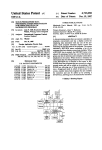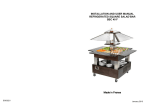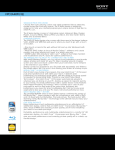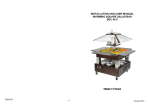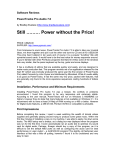Download Prestashop - 1.4 Seller's Guide
Transcript
PrestaShop Seller's Guide Customer Analysis It should be noted that visitors and customers are separate entities. A visitor is an unknown person (not yet registered or not connected) who is browsing your store. A client is a person that is recognized by your store (registered and connected). Attracting visitors In itself, making the number of visitors higher is not important. It mainly serves as an indicator for the evolution of your shop's popularity over a period of time. Getting more subscribers If you let your shop run itself without changing anything, the number of subscribers should be stable or decline slightly. A strong growth or a sharp decline are indicators of a change in your shop. There are a number of possible impacting changes: An advertising campaign can attract many visitors. All promotions, sales and contests attract a lot of attention and curiosity from visitors; it not only creates a healthy animation around your shop, but it also increases its traffic. Aesthetics: a change of theme can put off visitors. Spelling and clarity are also to be looked after. Impulsive buyer or planning purchaser? A buyer is called "spontaneous" (or "impulsive") when making a purchase unpremeditated at the mere sight of a product, or its conditions of sale (current promotion, description, photo, price ... ). A purchase is called "planned" when the buyer takes the time: To study each piece of information about a product, To compare this product to existing competitors on the market, To reflect its purchase and the consequences thereof. Considering the buyer's profile You must therefore take into account the importance of different sources and contexts of information, for both types of buyers. For example: A promotion may convince a spontaneous buyer. In order to entice a planning buyer, you should first study the various offers on the market in order to price your products correctly. Pay attention to your descriptions, photos and presentations, offer a wide choice of carriers with fast delivery... Indeed, every detail counts. Customer loyalty Sending a birthday gift to a client is one way to gain loyalty. Keeping a customer is more profitable than to conquering a new one. It is therefore imperative to get his loyalty, that is to say to get him to come back to your shop. Word of mouth is also a new way to have satisfied customers: an unhappy customer does not attract new ones. To achieve this, several methods exist: Punctual actions Vendor rewards (targeted promotions and personalized gifts - either product or service), non-vendor rewards (priority review of an order or product), monetary rewards (vouchers, discount, refund). Lasting actions Loyalty card and loyalty points, which not only promote merchantcustomer communication, but also offer benefits to customers (private offers, discounts). These operations not only encourage the customer to buy, but also to regularly return to your shop. Enliven the shop Of course, offers and advertising attract clients and visitors, creating movement in your shop. There are several ways to animate a shop Newsletter Regularly send emails to all customers of your shop, in order to give them information about new products or to address a particular topic. Polls and surveys Involving users by asking them questions about their use of the shop. This may include opinion polls and satisfaction surveys. Contests Set up games or competitions on your shop, be they promotional or not. They will not only animate the site, but also help increase traffic, and so participate in customer loyalty. Discussion Forum A place in which visitors and customers are offered the opportunity to send and read messages about the shop. An ideal feature to make your shop more interactive and encourage communication between users and you. Chatting A place for real-time discussion, helping form communities of interest. It may even enable the creation of new services (such as online help or assistance business). Targeting customers In order for each of your messages to have an impact, you must know which type of customers you are addressing. Knowing your audience is essential to choose the right tools and convince each target audience. Restricting the scope of your communication to a group of customers is the best solution if you want to provide more appropriate offers. Personal information about customers allows you to better define the profile of the typical customer, and tailor promotions on your website according to various criteria. Once customers are properly targeted Using this information in order to act on a target audience can increase sales. Launching an advertising campaigns solely designed for a group of clients who may be interested in a particular offer, and having it sent at specific times or to specific locations. Contact by email / newsletter from a group of clients. In case of problems... Real-time monitoring is not simply a tool to satisfy the curiosity of the merchants, it is an especially effective way to solve the problems of a client. If you have a problem with a client, or if a customer has issues with your shop, the customer's page within PrestaShop enables you can to focus on a particular client and view his specific configuration, settings and buying history. You can also follow a client during his navigation on your website, page after page, so that you can help in a timely and efficient manner. Products analysis Verifying the shop and its contents These statistics show you an overview of products to ensure consistency in your shop. It's not always easy to handle a whole shop. To avoid forgetting a product description, an automatic alert will suggest a complete description for items that do not have one yet. Focusing on the type of product that sells! The rankings show you the greatest or lowest successes among your products. Acting on a product's success If a product is popular, it would be wise to broaden the range of products tied to it. For instance, if a fountain pen is selling very well, you can offer other products related to this type of pen, such as a pen-holder, a pencil case... This is called cross-selling. If a product is not sufficiently consulted or bought, here are some tips: Review the consistency of its description, and accompanying photos. Check if this product has been placed in the right category, or if the name of its class is well chosen. Remember to communicate more about this product: push forward, launching a promotion on it, or an advertising campaign... If these solutions do not work, it would perhaps be better to focus on products that work, and remove it from your shop. Adopting a marketing strategy that suits best Each product follows a life cycle of its own. Divided into four major periods, a life cycle has specific characteristics, and various growth rates and marketing objectives. These four stages are: initiation, growth, maturity and decline. By identifying the period in which a product currently is, you may be able to adapt your marketing strategy for optimum efficiency. Identifying the phase of your product and act! During the launch phase: a product recently added to a market will have a moderate growth. You must heavily invest in promoting in order to inform the consumer, and get him to buy the new product. Your aim should be to get the product known, so do not hesitate to push it forward, organize games or put ads in place, in order to give it a good visibility. The more a product is visible to the consumer, the better its sells will be during the launching phase. During the growth phase: promotional costs and other costs are reduced, while sales are increasing. The aim is to support its growth as long as possible, improving product quality and expanding its product line in order to convince even more customers and retain existing ones, increasing the distribution, continuing communication campaigns, gradually lowering prices. During a phase of maturity: sales reach their peak, the pace slows down. The aim is to maintain the product top spot. It is a longer phase than the previous two, in which competition may be fiercer. Therefore, several options are available to meet your aim: Expand your market by targeting a different type of audience. Update your product line, by creating packs in order to boost sales. Retain customers. Change some elements of mix-marketing, such as price, distribution, or services. Analyze and understand the evolution of a particular product The statistics related to a unique product to help you understand why the product has undergone a sharp decline / rise. You can also use this data to rebuild your stock according to the evolution of sales of this product, or consult this data for informational purposes only. Ensuring the clarity of categories What makes people want to visit a category at first sight? A product category must have a name that attracts the visitor's attention: it must be meaningful and make people curious. Category names such as "Misc." or "Everything else" are not recommended. In addition, products placed in these categories are heterogeneous. So make sure that you name each category properly, and store each product in the category that fits it best. Putting a sponsorship system in place An advertising-per-propagation process spread, where a customer is rewarded (gift, discount, points) when he brings a new customer to your shop using a recommendation sent to his entourage. You can set up a sponsorship points system, in which the customer who registers can mention the e-mail address of his sponsor, who will then receive a large number of points for each. The sponsored customer can receive a welcome gift. If the sponsored customer becomes a sponsor for other people, his own sponsor will too benefit. This technique is very useful to get new customers, encourage word of mouth and still contribute to customer loyalty. Offering cross-selling Cross-selling is a commercial technique offering a complementary product when ordering. Cross-selling is available in various forms: Additional sales Intended to suggest products associated with the main product. For example, if your main product is an MP3 player, you can suggest a traditional range of products that complement the choice of an MP3 player (protective cover, speaker, connectors, headphones, headsets...). Up-selling or Upmarket Brings the consumer to go upmarket by buying a more expensive product than the one he initially chose. This technique can boost sales of the complementary product. For example, offer a high-end computer while the customer's choice was focused on a "midrange" computer. Secondary sales Your shop suggests products that are close to the ones chosen by the visitor. For example you put forward: "Movies by the same director" "Those who purchased this product also purchased" Packs The idea is to combine the main product with an accessory to a more attractive price than if the customer had purchased separately, in order to sell a product that the customer had not planned to buy. Example: a pack with a mobile phone and some accessories. Thus, by offering additional products to your existing line, you help increase the average shopping cart, and give visibility to products that have too few of it. The key is to communicate Advertising is a form of communication designed to draw attention and prompt the consumer to buy a product. So you must know your product in order to make it known if it is new, and increase the sales of an existing product, or the customer loyalty to your store. It is important to note that an advertising campaign cannot be judged solely on the number of visitors that it brings, but more importantly on the quality of these. Indeed, some visitors may just surf without buying anything. Others, more focused and perhaps fewer, may be better clients. There are several types of advertising "Pay-per-click" offers Before adding your ad in the search engine of your choice, you must set your budget. The higher the amount, the higher your ad will appear. We advise you to properly target your advertising so that it appears only in some countries or languages, and to carefully select each of your keywords. Also, to properly target the visitors you want. Product or bundle campaigns Having a banner or pushing a product forward on your own shop's homepage. Word of mouth (rewarded or through a referral system) Everyone is talking and communicating. The idea here is that the users themselves are sending recommendations to their entourage about an offer, a product, or the benefits of your shop. The information is spreading very rapidly, its reach is enhanced thanks the way people communicate on the Internet. Analysis of orders Tailor solutions to Clients Knowing the time control means for a client allows you to analyze its performance in an order, whether the purchase is generally reflected or spontaneous. Adjust your bids based on these behaviors, you can enlarge the description, add more photos, and then draw attention momentarily on a particular product for a short time ...). Adapting discounts to customers These data enable the merchant to know which are the customers' favorite vouchers, and how they use them. How to adapt these reductions? Determining the amount of such voucher is not clear. It must be a delicate balance between providing voucher that will encourage the customer to buy, and pay attention not to lose too much money because of a high amount. If a voucher is used all the time, you can slightly reduce its amount in order to save some money, given that this one already pleases a lot of users. You can also remove the vouchers that are seldom or never used. Goal What your goals should be It is a priority that you clearly define the objectives, ratios and key performance of your store. It is important to note that all these objectives should have a time limit in order to determine if they are met or not.









